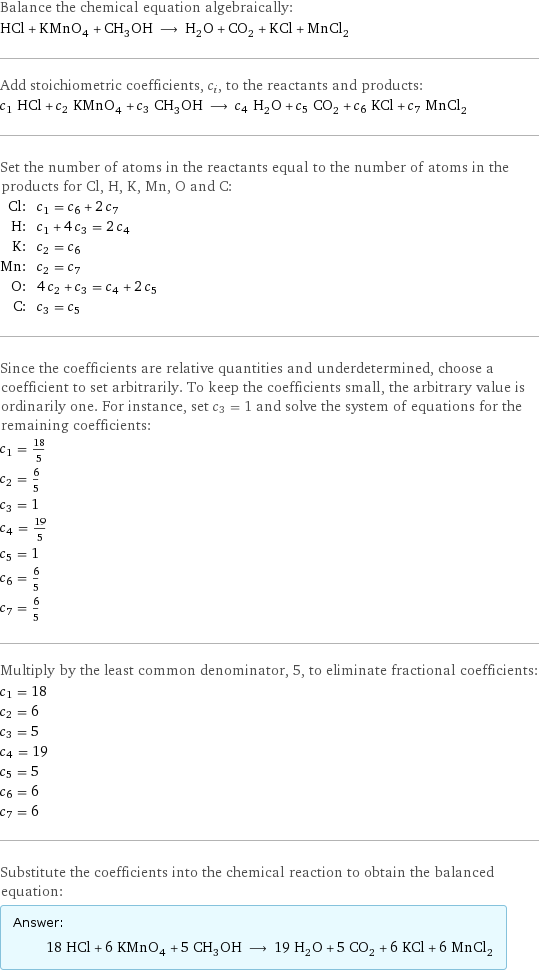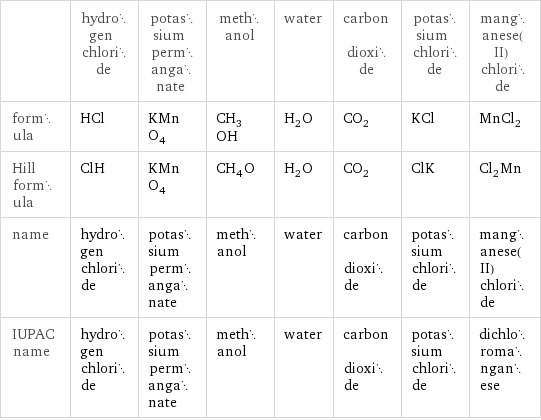Input interpretation

HCl hydrogen chloride + KMnO_4 potassium permanganate + CH_3OH methanol ⟶ H_2O water + CO_2 carbon dioxide + KCl potassium chloride + MnCl_2 manganese(II) chloride
Balanced equation

Balance the chemical equation algebraically: HCl + KMnO_4 + CH_3OH ⟶ H_2O + CO_2 + KCl + MnCl_2 Add stoichiometric coefficients, c_i, to the reactants and products: c_1 HCl + c_2 KMnO_4 + c_3 CH_3OH ⟶ c_4 H_2O + c_5 CO_2 + c_6 KCl + c_7 MnCl_2 Set the number of atoms in the reactants equal to the number of atoms in the products for Cl, H, K, Mn, O and C: Cl: | c_1 = c_6 + 2 c_7 H: | c_1 + 4 c_3 = 2 c_4 K: | c_2 = c_6 Mn: | c_2 = c_7 O: | 4 c_2 + c_3 = c_4 + 2 c_5 C: | c_3 = c_5 Since the coefficients are relative quantities and underdetermined, choose a coefficient to set arbitrarily. To keep the coefficients small, the arbitrary value is ordinarily one. For instance, set c_3 = 1 and solve the system of equations for the remaining coefficients: c_1 = 18/5 c_2 = 6/5 c_3 = 1 c_4 = 19/5 c_5 = 1 c_6 = 6/5 c_7 = 6/5 Multiply by the least common denominator, 5, to eliminate fractional coefficients: c_1 = 18 c_2 = 6 c_3 = 5 c_4 = 19 c_5 = 5 c_6 = 6 c_7 = 6 Substitute the coefficients into the chemical reaction to obtain the balanced equation: Answer: | | 18 HCl + 6 KMnO_4 + 5 CH_3OH ⟶ 19 H_2O + 5 CO_2 + 6 KCl + 6 MnCl_2
Structures

+ + ⟶ + + +
Names

hydrogen chloride + potassium permanganate + methanol ⟶ water + carbon dioxide + potassium chloride + manganese(II) chloride
Reaction thermodynamics
Gibbs free energy

| hydrogen chloride | potassium permanganate | methanol | water | carbon dioxide | potassium chloride | manganese(II) chloride molecular free energy | -95.3 kJ/mol | -737.6 kJ/mol | -166.3 kJ/mol | -237.1 kJ/mol | -394.4 kJ/mol | -408.5 kJ/mol | -440.5 kJ/mol total free energy | -1715 kJ/mol | -4426 kJ/mol | -831.4 kJ/mol | -4505 kJ/mol | -1972 kJ/mol | -2451 kJ/mol | -2643 kJ/mol | G_initial = -6972 kJ/mol | | | G_final = -11571 kJ/mol | | | ΔG_rxn^0 | -11571 kJ/mol - -6972 kJ/mol = -4599 kJ/mol (exergonic) | | | | | |
Equilibrium constant
![Construct the equilibrium constant, K, expression for: HCl + KMnO_4 + CH_3OH ⟶ H_2O + CO_2 + KCl + MnCl_2 Plan: • Balance the chemical equation. • Determine the stoichiometric numbers. • Assemble the activity expression for each chemical species. • Use the activity expressions to build the equilibrium constant expression. Write the balanced chemical equation: 18 HCl + 6 KMnO_4 + 5 CH_3OH ⟶ 19 H_2O + 5 CO_2 + 6 KCl + 6 MnCl_2 Assign stoichiometric numbers, ν_i, using the stoichiometric coefficients, c_i, from the balanced chemical equation in the following manner: ν_i = -c_i for reactants and ν_i = c_i for products: chemical species | c_i | ν_i HCl | 18 | -18 KMnO_4 | 6 | -6 CH_3OH | 5 | -5 H_2O | 19 | 19 CO_2 | 5 | 5 KCl | 6 | 6 MnCl_2 | 6 | 6 Assemble the activity expressions accounting for the state of matter and ν_i: chemical species | c_i | ν_i | activity expression HCl | 18 | -18 | ([HCl])^(-18) KMnO_4 | 6 | -6 | ([KMnO4])^(-6) CH_3OH | 5 | -5 | ([CH3OH])^(-5) H_2O | 19 | 19 | ([H2O])^19 CO_2 | 5 | 5 | ([CO2])^5 KCl | 6 | 6 | ([KCl])^6 MnCl_2 | 6 | 6 | ([MnCl2])^6 The equilibrium constant symbol in the concentration basis is: K_c Mulitply the activity expressions to arrive at the K_c expression: Answer: | | K_c = ([HCl])^(-18) ([KMnO4])^(-6) ([CH3OH])^(-5) ([H2O])^19 ([CO2])^5 ([KCl])^6 ([MnCl2])^6 = (([H2O])^19 ([CO2])^5 ([KCl])^6 ([MnCl2])^6)/(([HCl])^18 ([KMnO4])^6 ([CH3OH])^5)](../image_source/d7610585726a2b89a3b0298bbb11ae75.png)
Construct the equilibrium constant, K, expression for: HCl + KMnO_4 + CH_3OH ⟶ H_2O + CO_2 + KCl + MnCl_2 Plan: • Balance the chemical equation. • Determine the stoichiometric numbers. • Assemble the activity expression for each chemical species. • Use the activity expressions to build the equilibrium constant expression. Write the balanced chemical equation: 18 HCl + 6 KMnO_4 + 5 CH_3OH ⟶ 19 H_2O + 5 CO_2 + 6 KCl + 6 MnCl_2 Assign stoichiometric numbers, ν_i, using the stoichiometric coefficients, c_i, from the balanced chemical equation in the following manner: ν_i = -c_i for reactants and ν_i = c_i for products: chemical species | c_i | ν_i HCl | 18 | -18 KMnO_4 | 6 | -6 CH_3OH | 5 | -5 H_2O | 19 | 19 CO_2 | 5 | 5 KCl | 6 | 6 MnCl_2 | 6 | 6 Assemble the activity expressions accounting for the state of matter and ν_i: chemical species | c_i | ν_i | activity expression HCl | 18 | -18 | ([HCl])^(-18) KMnO_4 | 6 | -6 | ([KMnO4])^(-6) CH_3OH | 5 | -5 | ([CH3OH])^(-5) H_2O | 19 | 19 | ([H2O])^19 CO_2 | 5 | 5 | ([CO2])^5 KCl | 6 | 6 | ([KCl])^6 MnCl_2 | 6 | 6 | ([MnCl2])^6 The equilibrium constant symbol in the concentration basis is: K_c Mulitply the activity expressions to arrive at the K_c expression: Answer: | | K_c = ([HCl])^(-18) ([KMnO4])^(-6) ([CH3OH])^(-5) ([H2O])^19 ([CO2])^5 ([KCl])^6 ([MnCl2])^6 = (([H2O])^19 ([CO2])^5 ([KCl])^6 ([MnCl2])^6)/(([HCl])^18 ([KMnO4])^6 ([CH3OH])^5)
Rate of reaction
![Construct the rate of reaction expression for: HCl + KMnO_4 + CH_3OH ⟶ H_2O + CO_2 + KCl + MnCl_2 Plan: • Balance the chemical equation. • Determine the stoichiometric numbers. • Assemble the rate term for each chemical species. • Write the rate of reaction expression. Write the balanced chemical equation: 18 HCl + 6 KMnO_4 + 5 CH_3OH ⟶ 19 H_2O + 5 CO_2 + 6 KCl + 6 MnCl_2 Assign stoichiometric numbers, ν_i, using the stoichiometric coefficients, c_i, from the balanced chemical equation in the following manner: ν_i = -c_i for reactants and ν_i = c_i for products: chemical species | c_i | ν_i HCl | 18 | -18 KMnO_4 | 6 | -6 CH_3OH | 5 | -5 H_2O | 19 | 19 CO_2 | 5 | 5 KCl | 6 | 6 MnCl_2 | 6 | 6 The rate term for each chemical species, B_i, is 1/ν_i(Δ[B_i])/(Δt) where [B_i] is the amount concentration and t is time: chemical species | c_i | ν_i | rate term HCl | 18 | -18 | -1/18 (Δ[HCl])/(Δt) KMnO_4 | 6 | -6 | -1/6 (Δ[KMnO4])/(Δt) CH_3OH | 5 | -5 | -1/5 (Δ[CH3OH])/(Δt) H_2O | 19 | 19 | 1/19 (Δ[H2O])/(Δt) CO_2 | 5 | 5 | 1/5 (Δ[CO2])/(Δt) KCl | 6 | 6 | 1/6 (Δ[KCl])/(Δt) MnCl_2 | 6 | 6 | 1/6 (Δ[MnCl2])/(Δt) (for infinitesimal rate of change, replace Δ with d) Set the rate terms equal to each other to arrive at the rate expression: Answer: | | rate = -1/18 (Δ[HCl])/(Δt) = -1/6 (Δ[KMnO4])/(Δt) = -1/5 (Δ[CH3OH])/(Δt) = 1/19 (Δ[H2O])/(Δt) = 1/5 (Δ[CO2])/(Δt) = 1/6 (Δ[KCl])/(Δt) = 1/6 (Δ[MnCl2])/(Δt) (assuming constant volume and no accumulation of intermediates or side products)](../image_source/cdeac17c510614dcbd64d0f107837722.png)
Construct the rate of reaction expression for: HCl + KMnO_4 + CH_3OH ⟶ H_2O + CO_2 + KCl + MnCl_2 Plan: • Balance the chemical equation. • Determine the stoichiometric numbers. • Assemble the rate term for each chemical species. • Write the rate of reaction expression. Write the balanced chemical equation: 18 HCl + 6 KMnO_4 + 5 CH_3OH ⟶ 19 H_2O + 5 CO_2 + 6 KCl + 6 MnCl_2 Assign stoichiometric numbers, ν_i, using the stoichiometric coefficients, c_i, from the balanced chemical equation in the following manner: ν_i = -c_i for reactants and ν_i = c_i for products: chemical species | c_i | ν_i HCl | 18 | -18 KMnO_4 | 6 | -6 CH_3OH | 5 | -5 H_2O | 19 | 19 CO_2 | 5 | 5 KCl | 6 | 6 MnCl_2 | 6 | 6 The rate term for each chemical species, B_i, is 1/ν_i(Δ[B_i])/(Δt) where [B_i] is the amount concentration and t is time: chemical species | c_i | ν_i | rate term HCl | 18 | -18 | -1/18 (Δ[HCl])/(Δt) KMnO_4 | 6 | -6 | -1/6 (Δ[KMnO4])/(Δt) CH_3OH | 5 | -5 | -1/5 (Δ[CH3OH])/(Δt) H_2O | 19 | 19 | 1/19 (Δ[H2O])/(Δt) CO_2 | 5 | 5 | 1/5 (Δ[CO2])/(Δt) KCl | 6 | 6 | 1/6 (Δ[KCl])/(Δt) MnCl_2 | 6 | 6 | 1/6 (Δ[MnCl2])/(Δt) (for infinitesimal rate of change, replace Δ with d) Set the rate terms equal to each other to arrive at the rate expression: Answer: | | rate = -1/18 (Δ[HCl])/(Δt) = -1/6 (Δ[KMnO4])/(Δt) = -1/5 (Δ[CH3OH])/(Δt) = 1/19 (Δ[H2O])/(Δt) = 1/5 (Δ[CO2])/(Δt) = 1/6 (Δ[KCl])/(Δt) = 1/6 (Δ[MnCl2])/(Δt) (assuming constant volume and no accumulation of intermediates or side products)
Chemical names and formulas

| hydrogen chloride | potassium permanganate | methanol | water | carbon dioxide | potassium chloride | manganese(II) chloride formula | HCl | KMnO_4 | CH_3OH | H_2O | CO_2 | KCl | MnCl_2 Hill formula | ClH | KMnO_4 | CH_4O | H_2O | CO_2 | ClK | Cl_2Mn name | hydrogen chloride | potassium permanganate | methanol | water | carbon dioxide | potassium chloride | manganese(II) chloride IUPAC name | hydrogen chloride | potassium permanganate | methanol | water | carbon dioxide | potassium chloride | dichloromanganese